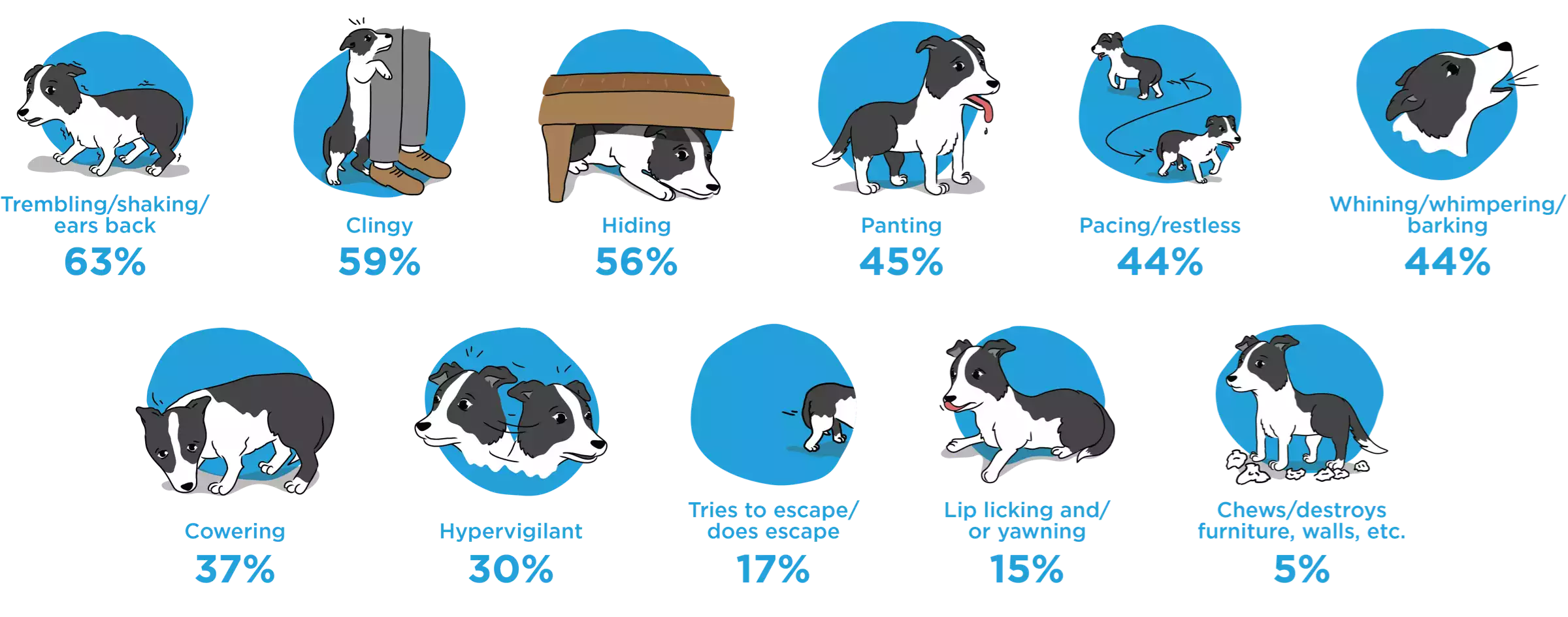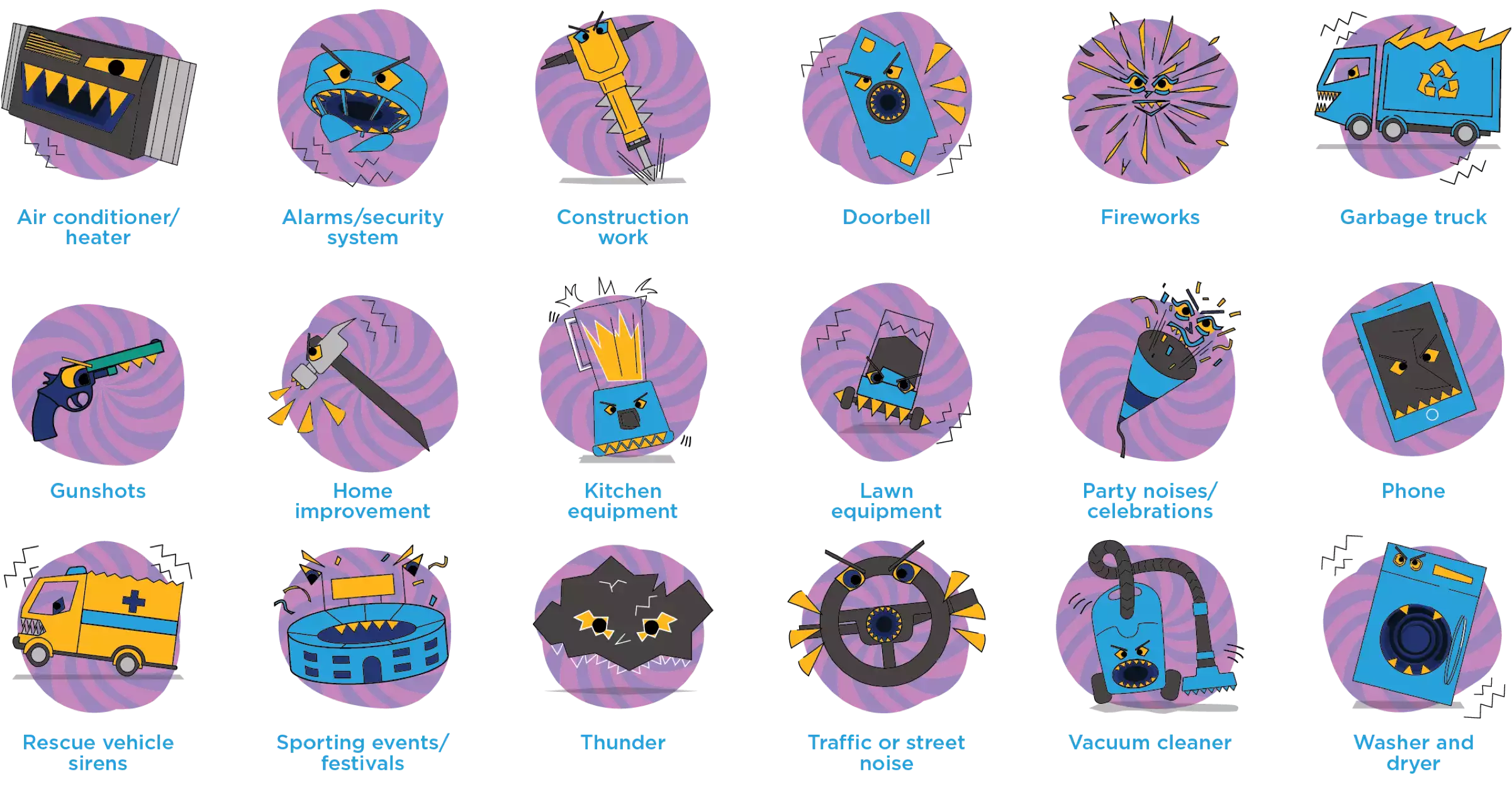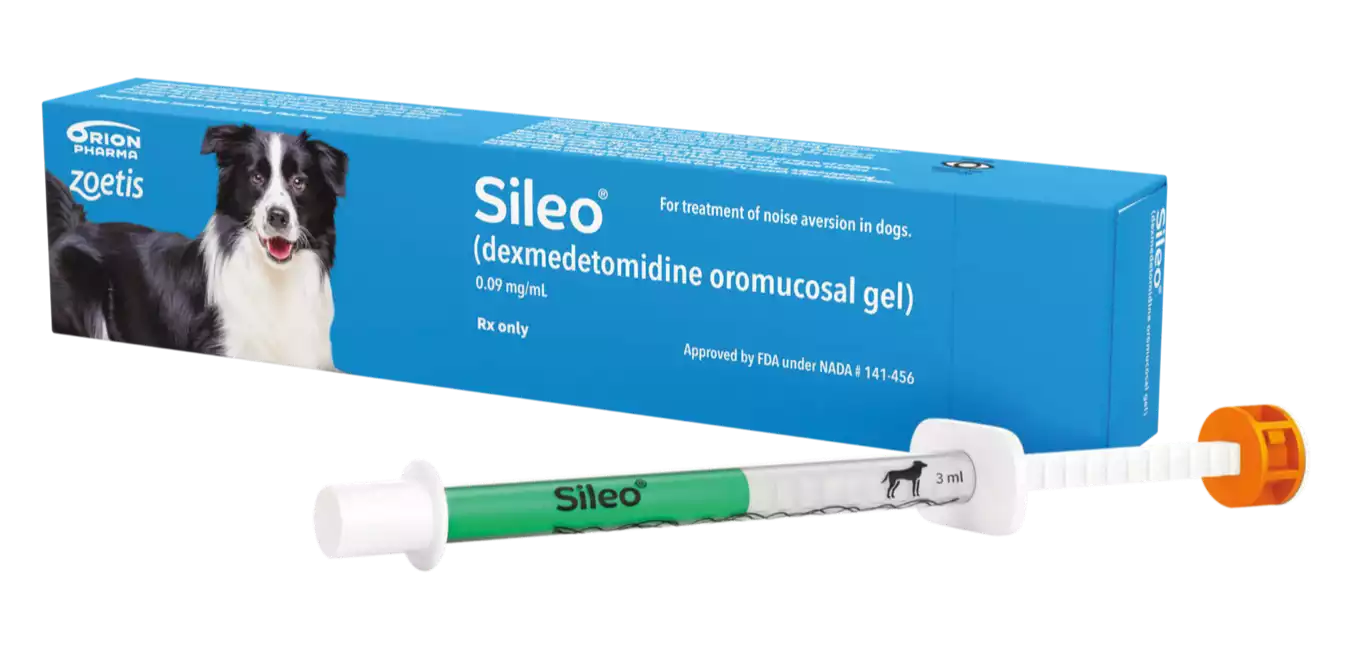
SATURDAY 11:00 AM
When Mom Unleashes the Vacuum Monster

Does Your Dog Overreact to Everyday Noises?
Help treat the fear of sound with Sileo.
Sileo® (dexmedetomidine oromucosal gel) is the first FDA-approved treatment for dogs that suffer from a serious condition called noise aversion. It is prescribed by your veterinarian to help keep your dog calm when they hear scary noises.
Does your dog show these signs of noise aversion?

What is Noise Aversion?
You may not realize that your dog is overreacting out of fear to sounds. There are many common signs your dog could be displaying that can help identify which noises, known as “triggers,” are causing them fear and anxiety. These reactions are known as noise aversion, a serious medical condition that is treatable with help from your veterinarian.

If you notice your dog overreacting to everyday noises around your home, he or she isn’t alone. In fact, 2 out of 3 dogs show signs of fear to loud noises.1
Noise aversion is not “normal” for dogs.
Overreacting to noise is a sign that your dog is fearful and anxious, similar to how you might react if you saw a monster! That’s why we call the sounds that bring fear and anxiety to dogs “noise monsters.” What may seem like a normal noise to you can be terrifying for your dog—like they’re in a horror movie that they can’t escape.
If Left Untreated, Noise Aversion Can Become Worse2-4
It can have a negative impact on your dog’s life and take away from the special bond you’ve built with your best friend.

What Are the Signs of Noise Aversion?
Imagine a monster jumped out from the darkness! How would you react? That's a similar feeling to what your dog can experience when hearing a loud noise. They think they're in danger and react out of fear.
Here are some of the signs of noise aversion and how commonly they are reported by dog owners like you5:

What Are the Causes of Noise Aversion?
Meet the “noise monsters”—sounds that can trigger fear and anxiety in dogs.
Sure, loud sounds like fireworks or thunder can strike fear in dogs. But did you know that everyday sounds around your home can cause a similar reaction?
Here are some of the sounds in and around your home that can frighten your dog:

Is Your Dog Experiencing Noise Aversion?
Find out where they rank on the Scare Scale!
Your answers to questions about your dog’s reaction to everyday noises around the house are the first step in helping stop the “noise monsters.”

Help Stop the Noise Monsters With Sileo
A simple, safe, and effective solution to noise aversion.
Sileo is a medicine prescribed by your veterinarian. It helps calm your dog when frightened by loud noises around your home without making them drowsy.
Sileo is different from other medicines:
- The first of its kind—Sileo is the first FDA-approved treatment for noise aversion in dogs
- Safe and effective—Clinically proven to work without other treatments or training6
- Given as needed—When your dog hears a scary noise, Sileo is easy to give and works fast to calm them down. No daily medication needed6
- Calms without making your dog drowsy—Helps stop fear and anxiety that they feel towards “noise monsters” while keeping your dog interacting normally with you and your family

Using Sileo
Here are some helpful resources to help you administer Sileo easily at home.
Minimize the Effects From “Noise Monsters” Around Your Home
Sileo can help you keep your dog calm when “noise monsters” scare them. There are also things you can do around your home to help keep your dog safe from scary sounds.
- Keep noises at a distance—Try to keep your dog away from sounds that trigger them to act out of fear and anxiety
- Use a classical distraction—Play music to cover up noises that scare your dog. Like many people, some dogs find classical music to be relaxing7
- Find a safe haven—Encourage your dog to go to a soundproof area such as a basement or bathroom. Once the sound starts, your dog can feel more comfortable. Talk with your veterinarian about setting up a safe space for your dog
- Act like the noise isn’t a big deal—Play with your dog, read a book, watch TV. Carry on normal activities. Your dog will see that you’re not scared, which may help keep them calm
- Be there for your best bud—Just being around your dog can comfort them
Things to Avoid
- Don’t punish your dog—If you discipline your dog for having an accident or destroying something in reaction to a loud noise, it can make them even more afraid. Remember, your dog is acting out of fear, not misbehaving
Frequently Asked Questions
Sileo is formulated as a gel that is absorbed into your dog’s body when you apply it to the mucous membranes between your dog’s cheek and gums. Dexmedetomidine (the active ingredient) calms your dog by preventing or reducing specific reactions in the nervous system.
Refer to the instructions on when and how to give your dog Sileo.
Sileo is administered by placing the gel between your dog’s cheek and gums. This allows the medicine to enter the bloodstream (transmucosal absorption).
Six dots equals 1.5 mL. This dose is too great to give to one side of the mouth. It can cause the medicine to be swallowed or to flow out of the mouth, which can decrease the effect of Sileo. Giving half of the dose on one side of the mouth and half on the other side helps to maximize the amount of medicine given to your dog.
No. This will cause incorrect dosing. Also, remember to wear impermeable gloves (gloves that liquids or gels cannot go through); see more in the human safety question below: “What if I’m exposed to Sileo”.
Yes, within 4 weeks, but only if there is enough gel remaining for a complete dose. This minimizes the risk of incorrect dosing.
Both new and partially used syringes of Sileo should be stored in the carton provided (protected from light) at room temperature.
State and federal medical waste laws apply. The easiest way could be to place the used syringe back into the box and return it to the veterinary clinic. Ask your veterinarian about proper disposal of empty or partially used Sileo syringes.
Very few adverse events have been reported with Sileo. Vomiting, sedation, and/or drowsiness were infrequently reported.
Avoiding food or treats for 15 minutes after dosing allows for maximal absorption of Sileo, without the food increasing the chance that some of the Sileo will be swallowed. If Sileo is swallowed, it will not be active.
Much of the extra gel may flow out of the mouth or be swallowed, which would limit the effects on your dog. In a worst-case scenario in which the entire syringe (3 mL) is accidentally applied to a smaller dog and is fully absorbed, mild to moderate drowsiness (sedation) may occur. As always, contact your veterinarian in any situation in which you feel your dog has received too much Sileo.
Although dexmedetomidine (the active ingredient in Sileo) cannot be absorbed through normal skin, it can be absorbed through breaks in the skin and through the eyes, nose, and mouth (mucous membranes). Therefore, as a precaution, you should wear impermeable disposable gloves when administering Sileo to your dog.
In the case of accidental exposure to the skin, the area should be immediately and thoroughly washed; remove contaminated clothing and contact your physician if you have questions.
If Sileo comes in contact with your eyes, nose, or mouth, it can be absorbed into your body, so you should flush the exposed area with water for 15 minutes.
If you are wearing contact lenses, flush the eyes, and then remove the contact lenses and continue flushing; seek medical advice immediately.
If the drug is absorbed into your body, it can cause symptoms such as lowered blood pressure (which may result in dizziness, fainting, lack of concentration, blurred vision, nausea, cold, clammy or pale skin, and/or rapid, shallow breathing), sleepiness, and slower heart rate.
Share the package information with your doctor and tell them that Sileo contains an alpha-2 adrenoceptor agonist.
Although the active ingredient in Sileo, dexmedetomidine, is approved for use as a sedative for humans, it has not been evaluated in pregnant women. Therefore, pregnant women are warned not to administer Sileo to their dogs.
IMPORTANT SAFETY INFORMATION: See Prescribing Information. Do not use Sileo in dogs with severe cardiovascular disease, respiratory, liver or kidney diseases, or in conditions of shock, severe debilitation, or stress due to extreme heat, cold or fatigue or in dogs hypersensitive to dexmedetomidine or to any of the excipients. Sileo should not be administered in the presence of preexisting hypotension, hypoxia, or bradycardia. Do not use in dogs sedated from previous dosing. Sileo has not been evaluated in dogs younger than 16 weeks of age or in dogs with dental or gingival disease that could have an effect on the absorption of Sileo. Sileo has not been evaluated for use in breeding, pregnant, or lactating dogs or for aversion behaviors to thunderstorms. Transient pale mucous membranes at the site of application may occur with Sileo use. Other uncommon adverse reactions included emesis, drowsiness or sedation. Handlers should avoid direct exposure of Sileo to their skin, eyes or mouth. Always review INSTRUCTIONS FOR USE before dispensing and dosing.
The product information provided in this site is intended only for residents of the United States. The products discussed herein may not have marketing authorization or may have different product labeling in different countries. The animal health information contained herein is provided for educational purposes only and is not intended to replace discussions with an animal healthcare professional. All decisions regarding the care of a veterinary patient must be made with an animal healthcare professional, considering the unique characteristics of the patient.
Sileo® is trademark owned by Orion Corporation Orion Pharma Animal Health. It is manufactured by Orion Corporation and distributed by Zoetis under license from Orion Corporation Orion Pharma Animal Health.
References
- The Harris Poll: Custom Motion Sickness and Noise Aversion Omnibus Pet Owner Quantitative Research Report; December 2018.
- Shull-Selcer EA, Stagg W. Advances in the understanding and treatment of noise phobias. Vet Clin North Am Small Anim Pract. 1991;21(2):353-367.
- Overall KL, Dunham AE, Frank D. Frequency of nonspecific clinical signs in dogs with separation anxiety, thunderstorm phobia, and noise phobia, alone or in combination. ? J Am Vet Med Assoc. 2001;219(4):467-473.
- Sherman BL, Mills DS. Canine anxieties and phobias: an update on separation anxiety and noise aversions. Vet Clin North Am Small Anim Pract. 2008;38(5):1081-1106.
- Data on File, 2016. Noise Aversion, Zoetis Inc. N=472 Dog Owners, N=454 General Practitioners.
- SILEO (dexmedetomidine). Prescribing information. Zoetis Inc; 2017.
- Wells DL, Graham L, Hepper PG. The influence of auditory stimulation on the behaviour of dogs housed in a rescue shelter. Anim Welfare. 2002;11(4):385-393.


